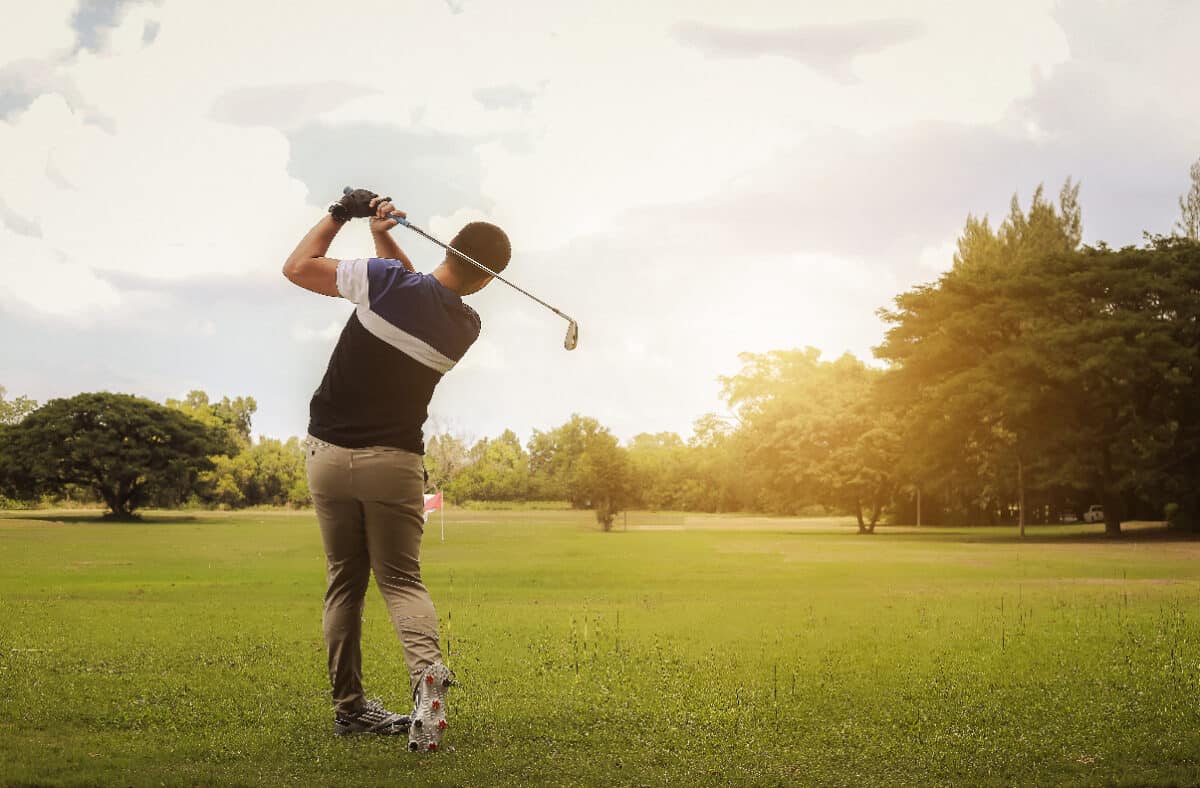How to Drive a Golf Ball? Detailed Steps
The driver is golf’s most exciting and challenging club to master. Being able to confidently drive the ball long and straight down the fairway is every golfer’s goal.
With proper technique, well-fitted equipment, and practice, you can hit powerful, accurate tee shots that find the fairway.
Follow these key steps to learn how to drive a golf ball like a pro.

Optimize Your Setup for Consistency
The foundation of an effective driver swing begins with proper setup positioning. Stand upright with an athletic posture, knees slightly flexed for balance.
Position the golf ball inside your front heel, tee height adjusted so the ball is lightly above centerface.
Keep your shoulders, hips, and feet aligned parallel left of your target line. Distribute body weight evenly between heels and toes.
Grip the club lightly but securely in your fingers – avoid tension in your hands, wrists, and forearms. A neutral, balanced setup like this positions your body to efficiently unwind into the backswing.
Hinge Wrists Fully on Backswing for Power
Initiate the backswing by hinging your wrists to bring the clubhead back low and inside. Maintain full wrist hinge as you continue lifting the club up and away from the ball.
Keep elbows pointed down and tucked in close to your sides for maximum leverage. At halfway, the shaft should be pointing right at the ball, with wrists cocked at a 90-degree angle – this loads power into your swing.
Avoid overswinging past parallel to the ground. Complete the backswing by rotating your shoulders and core fully to build torque.

Transfer Weight and Clear Hips to Unload Power
To begin the crucial downswing sequence, first clear your hips laterally towards the target as you transfer weight onto your front side.
Aggressively pull down with the lower body to start uncoiling power. Next, begin releasing the club by unhinging your wrists – this is key for creating high clubhead speed through impact.
Time the sequence so the wrists are fully unhinged just after the hips clear. Maintain spine angle relative to address – avoid swaying or straightening up.
The shoulders and chest should rotate hard to pull the arms and club down into the ball. Strike the ball with a slight downward angle of attack.
Follow Through for Maximum Distance
After compressing the golf ball at the bottom of the swing arc, continue swinging through impact with full arm extension toward the target.
The follow-through allows you to complete the uncoiling motion for optimal power transfer. Fully release the clubhead with arms extended out in front of the chest.
Rotate the chest upwards and hold a balanced finished position with weight shifted fully over the front foot.
Follow through until hands finish high above shoulders. Avoid stopping the swing abruptly after hitting the ball.

Engage the Body for Effortless Power
An efficient driver swing uses the entire body to build and channel power into the ball. It starts with coiling the upper body against a stable lower body in the backswing.
Then aggressively clearing hips to pull the core and transition force into the downswing. Well-timed hip and chest rotation adds leverage to the arms.
Finally, using the legs to brace against in the finish transfers power from the ground up. It takes full-body motion to compress today’s long-distance drivers.
Choose the Right Driver & Shaft for Your Swing
Investing in a reputable, forgiving driver brand optimized to your personal swing speed, launch angle, and spin rate is critical for maximizing distance.
Look for the adjustable loft to fine-tune trajectory. Regular or stiff shaft flex matches slower or faster swing speeds. MAX drivers with rearward CG suit newer players.
The right driver gives you the best chance to send the ball flying far down the fairway.
Use Premium Balls that Launch High with Low Spin
Pair distance-focused drivers with golf balls engineered to launch high off the tee with low driver spin for optimum distance.
Surlyn covers and soft compressible cores add ball speed. Align the ball with an upswing to reduce the slicing spin.
Consider firmer balls that spin less for straighter flights if you already generate high spin.
Tweak Adjustable Settings to Optimize Flight
Many modern drivers allow customizing adjustable hosel and weighting settings. With practice, golfers can optimize face angle, loft, lie angle, CG placement, and other attributes to achieve ideal launch conditions.
Work with a club fitter to test combinations and analyze results on launch monitors. Refine adjustable features to correct slices, eliminate spin, or promote high-launching bombs.
Relax Grip Pressure for Speed and Fluidity
Overgripping the club dramatically reduces swing speed, fluidity, and consistency. Eliminate excess tension in hands, wrists, and forearms for effortless delivery of the clubhead.
But maintain a secure grip to control the clubface through impact. Finding this balance allows maximum speed with solid contact.
Match Swing Path to Desired Ball Flight
Swing path directly influences shot shape and trajectory. An outward path adds left to right sidespin for gentle fade or slice.
The inside path creates a draw-spin. Swing up on the ball to launch it high with a backspin. Swing downward to a lower trajectory and spin. Match your driver’s path and angle to the shot shape and flight you want.
Always Tee Shots Up for Consistent Contact
Driving from a tee ensures clean, consistent ball contact and maximizes distance. The tee elevates the ball to optimal height in your stance.
Wooden tees allow adjusting the height as needed based on the desired trajectory. Carry spare tees in your pocket to replace damaged ones. Teeing up every drive makes solid contact easier.
Use Technology for Instant Feedback
Take advantage of launch monitors, golf simulators, and swing/shot tracking apps to receive instant feedback on your drive metrics.
Analyze clubhead speed, launch angle, spin rates, curvature, apex height, and total distance. Then work to correct flaws and repeat good shots. Data accelerates the mastery process.
With proper fundamentals, practice, and optimized equipment, you’ll hit drives you’re proud of. Strive for power, accuracy, and consistency off the tee.
Mastering the driver remains golf’s most exciting challenge with big rewards.


